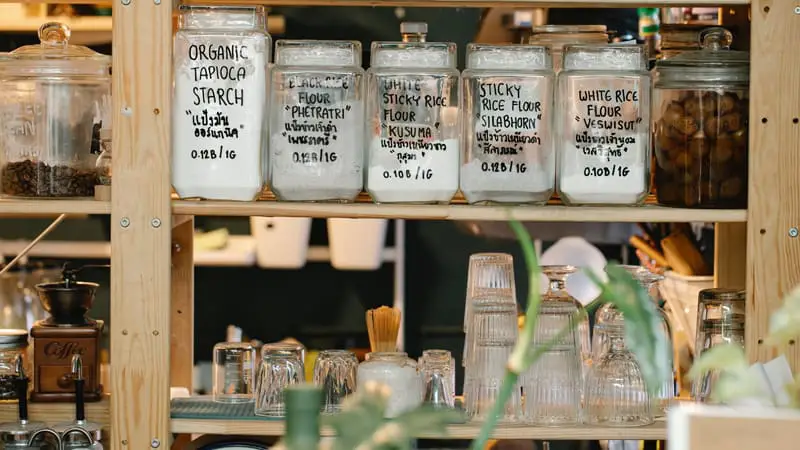The location of a pantry may be a slight afterthought following the design of a kitchen, but the placement of a pantry can be crucial. If put in the wrong spot, it can be in too warm of a location without adequate ways to ventilate it. So how do you cool down your pantry?
A pantry can be made cooler by removing insulating materials and by building it out of stone, tile or rock. You can also install a vent or duct to pipe cool air in or connect it to an air conditioning system. Moving heat generating appliances away will help as well.
I’ll take you through how to build a pantry that is cool, full of storage options and will keep your food for longer. We’ll also look at some tips to cool down your existing pantry if renovations are not possible.
How To Build a Cold Pantry?

Before the rise of appliances like refrigerators, to keep foodstuffs cool there was widespread use of larders and cellars.
These same techniques can still be used to build a pantry that will stay cool.
The first step is selecting the right place for the new pantry. While most people want to have a pantry close to the kitchen, this won’t always be the best place for it if you want to keep it cool.
Pick a room that is on the north-facing side of your property. This will help reduce the amount of direct sunlight warming it up over the day.
Try and maximize the surface area of the pantry to the outside by having as much of the pantry located in an area with at least one pantry wall being on an external-facing wall. This gives the heat somewhere to dissipate.
Great candidates for a cooler pantry can include cupboards under stairs or near garages. Whitegoods and other electronic devices are going to be outputting heat, so it’s best to keep your pantry away from these sources of heat.
There are also so many different types of insulation that will cause a room to heat up that can be removed to make a nice, cool pantry.
Remove carpet, wood and any roof insulation and stick to materials like tile, stone or brick. To keep the temperature constant, a sealed door will prevent cool air escaping and hot air from getting in.
How Can I Make My Pantry Colder?

Improving ventilation is one of the most effective ways to lower temperature. Small windows or vents can let in the cool air from outside. These windows should also be facing north and covered with netting or otherwise blocked off from sunlight and pests.
These vents will need to be fully closeable, as winter temperatures are apt to freeze the contents of a pantry utilizing the power of nature to keep the temperature low.
If you have air conditioning running in your house, you can leave the pantry door open to be cooled by the air’s ambient temperature.
Basements are one of the best places for storage of foods and are an often underutilized section of houses.
Amazon stocks the Amazon Basics 5-Shelf Storage Unit that comes on 4 inch wheels for easy movement. You can grab a few of these for your basement corner and stack up to 300 pounds per shelf.
Basement storage takes advantage of the fact that underground spaces tend to retain heat better due to the ground staying cold for longer.
Should a Pantry Have Ventilation?
The original pantries date back hundreds of years and originally served as the bread store. Any bread-related food preparation would also happen in these rooms.
The pantry was always seen as different from a larder, which was specifically for the storing of meats.
You should have some form of ventilation to help control odors, moisture, and heat.
Letting moisture in is a surefire way to get mold, pest infestations, and a whole host of other undesirable outcomes. If you live in a high humidity climate, this will make the issue even worse and ventilation is an absolute necessity.
Another option is to use cabinets inside the pantry that have a tight seal. This can enable you to store items long term while also minimizing any odors. Glass door cabinets also give you the great option of being able to clearly see what is in each cabinet with a single glance.
Passive and Active Ventilation

There are two main ways to achieve ventilation.
Passive ventilation relies on the natural world and the operation of air pressure to cause the flow of cool air. The main ways to do this are via windows or ducts.
Active ventilation would involve the installation of a fan, pump or other ducted system to regulate air flow mechanically. By combining temperature sensors with a feedback system, you can keep the pantry at an exact temperature of your choosing all year.
This of course will add a running cost to your pantry, so consider carefully what your goals are around the pantry.
Should I Put a Window in My Pantry?
Windows are a great solution to the ventilation needs of a pantry. However, a modern home is less likely to have had the kitchen built with the needs of a classical pantry or larder in mind.
Instead, given the ubiquity of appliances like refrigerators and ovens, storing and cooking food doesn’t require a pantry to maintain food like previous generations had to deal with.
This can mean that as the kitchen and therefore pantry are built in the center of the house, the possibility of having a window to the outside is impossible.
To remove exhaust fumes and help with airflow, range hoods or other ducted systems to run a suction fan above the stovetop will take the place of a window.

